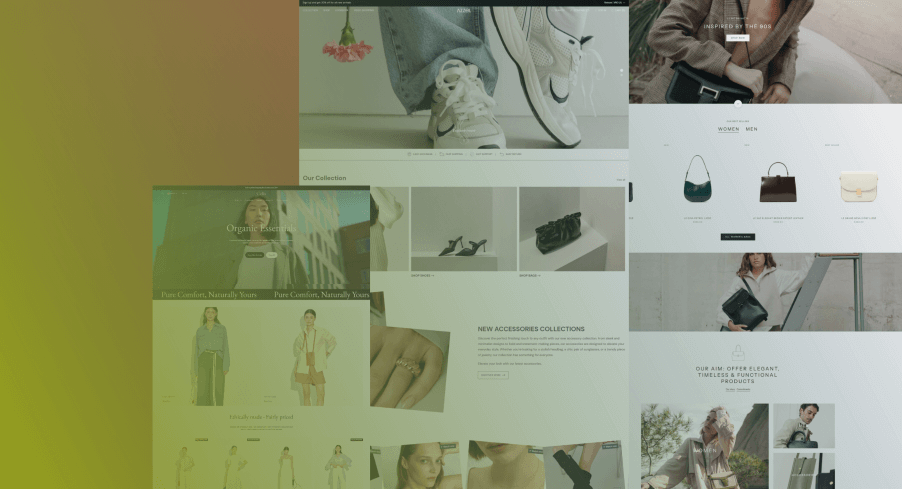-
TABLE OF CONTENTS
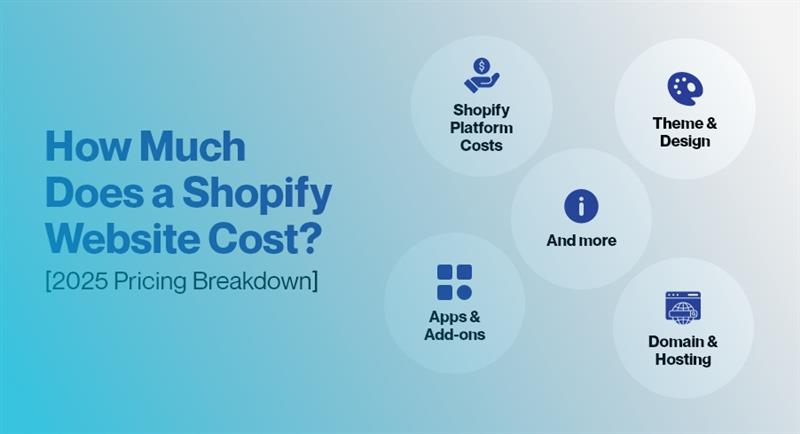

TL;DR – Shopify Website Cost in 2025
A Shopify website’s cost depends on your design approach, store complexity, and growth plans.
This guide covers platform plans, themes, design, development, apps, and marketing—so you can build a realistic budget, avoid hidden expenses, and scale without costly redesigns.
Shopify Website Cost Guide 2025: From Build to Growth
If you’re building a Shopify store in 2025, you want real numbers, clear examples, and a full picture of what drives your total cost — not vague “it depends” answers.
This guide will walk you through every major factor: platform plans, theme choices, design and development options, essential apps, marketing investments, and the real cost of ownership over time.
We’ll break down every major factor—from platform plans and themes to development, apps, marketing, and the real cost of ownership—so you can:
- Budget based on where your store is right now
- Plan ahead for growth (and what it’ll really cost)
- Dodge common budget traps that kill ROI later
But before we go deep, here’s a high-level view:
Shopify Website Cost at a Glance (2025) |
|||
|---|---|---|---|
| Store Type | Setup Cost (CAD) | Ongoing Monthly | What’s Included |
| DIY Starter | $300–$1,000 | $50–$150 | Free or paid theme, core apps, Shopify plan |
| Growing Brand | $3,000–$15,000+ | $500–$2,500+ | Custom design, essential apps, SEO, basic content + CRO, marketing |
| Scaling / Custom | $15,000–$60,000+ | $2,000–$8,000+ | Full UX design, custom dev, advanced CRO, support + growth ops |
Real Examples: What Do These Shopify Cost Tiers Look Like?
If you’re wondering what a $5K, $15K, or $40K Shopify site looks like, here are real client builds we’ve delivered—mapped to typical budgets:
Real Shopify Builds: What It Takes to Launch and Scale
|
||||
|---|---|---|---|---|
| Project | Type | Scope Highlights | Estimated Build (CAD) | Build Time |
| Larch Life | Scaling Store (Sustainable Home Products) |
Theme customization, bundles, visual design, blog content, basic SEO set up | ~$6,000–$7,000 | 3-4 weeks |
| FHENY | Growing Brand (Fashion) | Custom styling, minimalist branded UX, optimized for mobile, app integrations | ~$10,000–$12,000 | 5-6 weeks |
| Vassi.ca | Growing Brand (Apparel) | Collection filters, branded UX, custom fonts, mobile-first navigation | ~$10,000–$15,000 | 7-8 weeks |
| Fence Armor | Growing Brand (Fence Products) |
Mid-size catalog, UX optimization, CRO, educational content, SEO, email + reviews integrations, | ~$18,000–$20,000 | 8-10 weeks |
| Canadian Down & Feather | Enterprise- Shopify Plus / Complex (Home Bedding) |
Advanced filtering, ERP integration, wholesale logic, CRO-focused UX | $35,000–$60,000+ | 14-18 weeks |
These are real Shopify websites that the Ecommerce Development Pros team launched, optimized, and continues to support.
Shopify Website Design Cost: What You’re Actually Paying For
There’s no single number that fits every Shopify store.
The cost depends on what you’re trying to build—and how you plan to build it.
Some businesses want something simple- A clean theme, a few core pages, just enough to start selling fast.
Others need a fully custom experience- with advanced filters, app integrations, custom checkouts, and more..
So when someone asks us:
“How much does a Shopify website cost?”
We don’t throw out a random number.
Instead, we look at a few key factors:
- What kind of design and layout do you need?
- How much functionality does your store require?
- Whether your content is ready (or needs to be created).
- And what tools or systems do you use to grow after launch?
Most Shopify websites involve some combination of the following, and that is what impacts the overall Shopify website cost:
- Shopify Platform Costs
- Theme & Design
- Development & Functionality
- Apps & Add-ons
- Domain & Hosting
- Payment Processing & POS
- Content Creation
- SEO & Conversion Optimization
- Compliance & Security
- Maintenance & Support
- Marketing and Promotion
You might not need all 11 on Day One.
But if you want to build a store that grows with you, you need to know what they are.
Here’s what each part typically costs.
Shopify Website Costs Snapshot [2025 updated]
Here’s a quick breakdown of typical Shopify website costs—from DIY builds to full-scale, professionally developed stores.
Shopify Website Cost Breakdown by Category |
||
|---|---|---|
| Category | Typical Cost | What It Includes |
| Platform Plan | $49–$517 CAD/month (Shopify Plus from USD 2,300) | Shopify plan, hosting, SSL, built-in AI tools |
| Theme & Design | $0–$500 USD (theme) + $3K–$20K+ (theme customization or custom theme) | Theme purchase, design work, and UX enhancements |
| (one-time) | ||
| Development | $5K–$20K+ (one-time) |
Custom features, apps and third-party integrations, and consultation to build it right |
| Apps & Add-ons | $50–$1,000/month+ | Tools for email, reviews, subscriptions, SEO, analytics, and upsells |
| Domain & Hosting | $20–$50/year | Domain cost (hosting is included in the Shopify plan) |
| Payment & POS | 2.4%–2.8% + 30¢ per sale | Shopify Payments fees, plus optional POS hardware |
| Content Creation | $0–$10K+ | Copy creation for product descriptions, collection, blog posts, images (stock or custom photoshoot), and video production |
| SEO & CRO | $500–$5K+/month | On-page SEO, schema setup, site speed, CRO testing |
| Compliance & Security | $100–$3K+ | GDPR, CCPA, WCAG updates, privacy tools |
| Maintenance & Support | $100–$2K/month | Updates, bug fixes, monitoring, CRO enhancements, and ongoing support |
| Marketing Tools | $1k–$15K+/month | Ads, email marketing, social management, UGC platforms |
| Marketing and Promotion | $1k-$15k+/month | SEO, SEM, PPC (Google Ads), Meta/TikTok ads, email/SMS marketing, influencer campaigns, and affiliate programs. Cost varies by ad spend (media budget), campaign complexity, and in-house vs agency execution. |
Now that you’ve seen the full cost landscape, let’s break each part down, starting with the one you can’t skip:
1. How Much Does a Shopify Plan Cost in 2025 (And Which One Should You Choose?)
Let’s start with the first cost you’ll run into- your Shopify subscription plan.
Shopify plans in 2025 range from CAD 49 to CAD 517/month, with Shopify Plus starting at USD 2,300/month for high-volume stores.
What Does Each Shopify Plan Include?
Here’s a quick breakdown of Shopify’s core plans in 2025.
Shopify Plans Cost – 2025 updated |
||||
|---|---|---|---|---|
| Plan | Monthly / Annual (CAD) | Best For | Core Features | 2025 AI Features |
| Basic | $49 / $37 | New stores, just getting started | Hosting, SSL, Shopify Payments, Sidekick AI, Basic reports | AI Store Builder, Sidekick AI, Horizon theme access (latest free Shopify themes) |
| Grow | $132 / $99 | Growing brands with a team | Everything in Basic, plus standard reports, and more team logins | AI Catalogue (limited), Sidekick AI, Smart theme support |
| Advanced | $517 / $389 | Scaling stores with complex needs | Custom reporting, shipping automation, and international logic | AI Personalization, Smart checkout, B2B pricing |
| Shopify Plus | From USD 2,300/month | High-volume or B2B stores | Wholesale tools, multi-store control, and automation APIs | Full AI suite—catalogue, personalization, workflows |
Source: Shopify.com
How to Choose the Right Shopify Plan
Start with the plan that fits your next 3–6 months—not just your launch day.
Here’s how to think about it:
- Team Size- Just you? Basic is fine. Got a team? Start with Grow.
- Reporting Tools- Basic is limited. If you run ads or need insights, upgrade your plan.
- Selling international or B2B- Go with Advanced or Plus for shipping, duties, and wholesale tools.
- Want AI features in 2025- All plans include Sidekick. But the full AI suite? That’s in Advanced and Shopify Plus.
- Scaling fast- Skip the plan you’ll outgrow in 3 months. It’ll save you the hassle.
2. How Much Does a Shopify Theme Cost in 2025?
Your theme is your storefront.
It sets the tone for your brand, your customer experience—and yes, even your conversions.
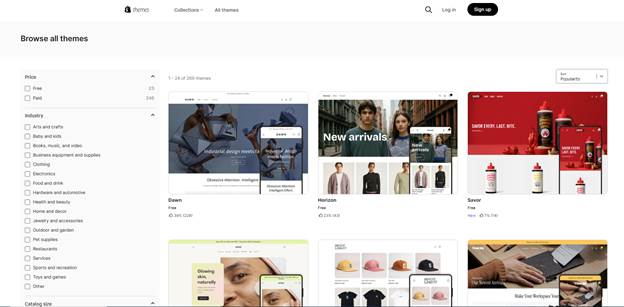
But what you choose depends on where you’re at, what you need, and how fast you’re growing.
Shopify themes range from $0 to USD 500, while fully customized themes can cost $5,000 to $60,000+, depending on the design scope.
So… how much should you budget?
Shopify Theme Costs |
||
|---|---|---|
| Theme Type | Cost Range (CAD) | What You Get |
| Free Shopify Themes | $0 | 24 official free themes by Shopify, including 10 new Horizon theme collections. Clean, modern, fast, and regularly updated. |
| Paid Shopify Themes | $100–$500 (one-time) | 850+ premium options on the Shopify Theme Store. More layouts, sections, performance, and mobile UX. |
| Third-Party Marketplace Themes | $50–$450 per year | Wider design variety, but quality varies. Often needs developer cleanup. |
When to Use Shopify’s Free, Paid Theme, or a Third-Party Theme?
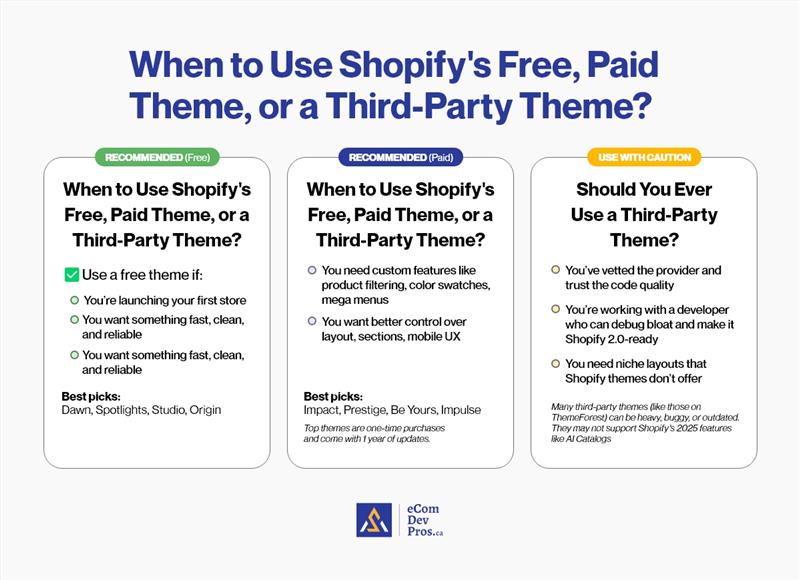
Benefits of using official Shopify Themes
For long-term peace of mind, we recommend going with official Shopify themes.
Shopify Official Themes vs Third-Party Themes |
||
|---|---|---|
| Feature | Shopify Official Themes | Third-Party Themes |
| Updates | ✅ Free, lifetime updates (built for Shopify’s roadmap) | ⚠ Usually 6–12 months of updates, then paid or none |
| Support | ✅ Direct support from Shopify | ⚠ Varies by vendor—response times and quality aren’t guaranteed |
| Compatibility | ✅ Always up-to-date with latest features & releases | ⚠ May lag behind with Shopify updates (OS 2.0, AI tools, etc.) |
| Code Quality | ✅ Clean, optimized, and vetted by Shopify | ⚠ Mixed quality—some great, some bloated or poorly structured |
| Security | ✅ Reviewed for vulnerabilities and performance | ⚠ Depends on vendor—less oversight, higher risk |
| Pricing | 💲 $100– USD 500 (one-time) | 💲 $50–USD 450 (some cheaper, but riskier)- recurring annual fee to receive updates |
| Scalability | ✅ Built to handle growth and performance needs | ⚠ May need developer workarounds for custom or growing stores |
| AI Feature Readiness (2025) | ✅ Compatible with Sidekick AI and smart blocks | ⚠ Most do not support AI integrations out of the box |
How to Choose the Right Shopify Theme
Picking a theme isn’t just about looks. Here’s what to consider:
- Small catalogue or launch fast? – A free theme with a clean layout and simple navigation
- Selling more than 20–30 products? – Themes with advanced filters, mega menus, and sorting
- Want a highly branded experience? -Paid themes with visual flexibility and content blocks
- Planning to scale quickly? – Themes that support performance, CRO, and AI features
- Using a lot of third-party apps? – Official themes are tested for app compatibility
Interested in learning more about choosing the right theme? Refer to our complete guide for Shopify theme selection.
3. How Much Does Shopify Development Really Cost? (And What Features Are Worth Paying For?)
Theme controls the look. Development controls the logic.
Development covers everything from setting up filters so customers can find products… to building custom features like “build-your-own box,” subscriptions, or wholesale pricing.
It’s where things get powerful—but also pricey.
Shopify development costs range from $3000 for a basic setup to $30,000+ for a fully custom store with advanced features and integrations.
Shopify Development Cost (2025) |
||
|---|---|---|
| Type of Work | Cost Range (CAD) | What This Actually Means |
| Basic Setup | $2000–$4,000 | Someone helps you launch faster—uploading products, setting up pages, menus, shipping, and taxes. |
| Add-On Features | $1000–$5,000 | Things like product bundles, customer accounts, subscription options, or “back in stock” alerts. |
| Custom Features | $3,000–$15,000+ | Build-your-own-product flows, advanced filters, custom cart logic, or wholesale pricing tools. |
| Full Custom Store | $8,000–$40,000+ | A store built from scratch—designed and developed around your exact products, customers, and workflows. |
After the budget, the next question we get is:
“How Long Does It Take to Launch a Shopify Store?”
The answer? It depends on what you’re building. We’ve included estimated timelines below:
Shopify Store Build Timelines by Type |
|
|---|---|
| Build Type | Estimated Time to Launch |
| DIY (No Dev Help) | 1–2 weeks |
| Theme-Based Build | 4-8 weeks |
| Custom Functionality | 10-16 weeks |
How to Make Smart Development Decisions (Even on a Budget)
✅ Start with what helps customers buy.
Prioritize user experience (UX). Help shoppers find what they need and check out smoothly.
✅ Use fewer apps and choose them wisely.
Don’t stack 4 apps when 1 well-built can handle it all.
Look for tools that cover multiple needs—like bundling, subscriptions, and upsells—without slowing your site down.
✅ Launch with the essentials. Add the rest when it earns its place.
Every extra feature is a distraction until you’ve tested what customers actually use.
✅ Custom code is a commitment—use it intentionally.
Every custom feature adds future maintenance, testing, and dev & ongoing costs.
Before you build it, gut-check it:
Does it help customers shop faster, increase conversions, or save you real time?
If not, skip it—or save it for later.
4. How Much Do Shopify Apps and Add-ons Cost Each Month?
Most Shopify stores spend $50 to $500+ per month on apps, depending on what stage they’re at and which features they need.
Shopify has over 8,000 apps, from reviews and popups to subscriptions, bundles, filters, and loyalty programs.
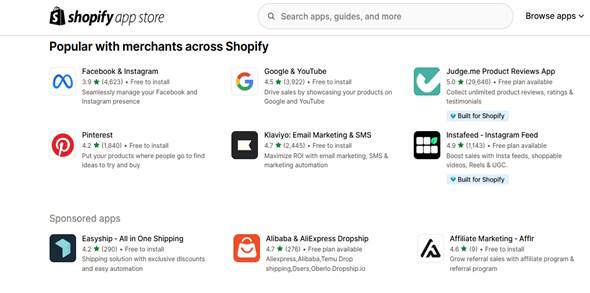
And most are plug-and-play. No dev required.
But here’s the problem:
Apps pile up fast. So does your monthly bill.
Worse? Too many apps slow down your store, and that kills conversions.
So, What Do Stores Actually Use?
Here’s what we see most stores add over time:
Recommended Shopify Tools & Features by Growth Stage |
||
|---|---|---|
| Start | Grow | Scale |
| Klaviyo /Omnisend for email marketing | Smart filters (Boost) | AI-based product recommendations |
| Judge.me or Loox for reviews | Recharge subscriptions | Multi-store sync tools |
| Free shipping bar/popups | Bundles, upsells-Reconvert | B2B pricing & logic apps |
| SEO/meta tools-SEO Manager or Yoast | Loyalty & referral programs- Smile.io, Yotpo | Advanced analytics integrations |
| Shipping – Shipstation, Ezy Ship | CRO apps- ConvertFlow or similar | Advanced CRO – Okendo, KnoCommerce |
How much does Shopify Apps cost?
App pricing varies, but here’s what we typically see across the board:
Shopify App Pricing Breakdown |
||
|---|---|---|
| App Type | Monthly Cost (CAD) | Notes |
| Basic utilities | $10–$30 | Includes announcement bars, cookie banners, and SEO helpers |
| Conversion tools | $20–$100 | Think upsells, exit popups, SMS, reviews |
| Subscriptions & bundles | $50–$300+ | Recharge, Loop, Bold Bundles, etc. |
| Loyalty & personalization | $100–$500+ | Smile.io, Yotpo, or advanced AI product engines |
Note: Most stores spend $50–$500/month on apps, depending on stage and complexity.
How to Avoid App Overload
Here’s a smarter approach:
- Be intentional. Only add an app if it solves a clear problem or drives conversions.
- Pick platforms that bundle tools. Some apps handle 3–4 features in one (like Vitals, which combines features like upsells, reviews, and conversion tools).
- Check your load speed. Apps can slow down your site. Run a speed test after every install.
- Audit quarterly. Set a calendar reminder. Cut what’s not moving the needle.
5. How Much Does a Domain and Hosting Cost on Shopify?
All Shopify plans include free hosting, fast servers, built-in CDN, SSL certificates, and 99.9 % uptime managed by Shopify.
What You Do Need to Think About: Your Domain
Your domain name is what people type to find your store online, like yourstore.com.
Shopify lets you:
- Buy a domain through Shopify – easiest, but slightly more expensive
- Use a domain from another provider, like GoDaddy or Namecheap
Here’s what Domain and Hosting cost:
What Domains, Hosting, and
|
||
|---|---|---|
| Item | Cost (USD) | Notes |
| Domain via Shopify | ~$20/year | Super easy setup. Managed right in your Shopify dashboard. |
| Domain via GoDaddy, Namecheap, etc. | $10–$50/year | Slightly cheaper. You’ll just need to connect it manually. |
| Hosting | $0 | Fully included with your Shopify subscription. |
| SSL / Security | $0 | Also included. |
Our Advice
✅ Buy your domain early — A good name is a small cost with a big brand impact.
✅ Keep your domain separate — It gives you flexibility if you ever replatform or use subdomains.
✅ Avoid unusual extensions — Stick to .ca, .com, .store, or relevant ones that customers trust.
6. How Much Does Shopify Payment Processing & POS Cost?
Shopify makes it easy to take payments, but you pay for that convenience.
Shopify Payment Processing & POS Fees by Plan |
|||
|---|---|---|---|
| Shopify Plan | Online Rate | In-Person (POS) Rate | Third-Party Processor Rate (Like PayPal or Stripe) |
| Basic | 2.8% + 30¢ per sale | 2.6% per transaction | 2% additional |
| Grow | 2.6% + 30¢ | 2.5% per transaction | 1% additional |
| Advanced | 2.4% + 30¢ | 2.4% per transaction | 0.6 % additional |
| Shopify Plus | Custom rates | Custom rates | 0.2 % additional |
Source: shopify.com
What does a POS (Point of Sale) cost?
If you sell in person (pop-up shops, retail, markets), Shopify offers:
- Shopify POS Lite – included with every plan
- Shopify POS Pro – $89/month per location
The free version is fine for basic selling. But if you need things like staff roles, inventory sync, or advanced reporting, you’ll want POS Pro.
Hardware (like a card reader or barcode scanner) comes with an extra cost of $50-$500, depending on the setup.
How to Lower Your Payment Processing Costs
- Use Shopify Payments– Avoid the extra fees from third-party processors.
- Upgrade plans if volume increases – Higher plans = lower fees per sale.
- Consider Shopify Plus if you’re high-volume – Shopify Plus offers custom rates for bigger stores.
- Check for POS fee leaks – Many stores pay for POS Pro when Lite would be enough.
7. How Much Does Shopify Content Creation Cost?
Design grabs attention. Content is what moves people to act.
It shows the value, answers the questions, and gives people a reason to click “Add to Cart.”
Content creation for Shopify stores typically ranges from $0 (DIY) to $10,000+, depending on whether you’re writing in-house, hiring freelancers, or producing visuals and video.
What Content Do You Actually Need?
- Homepage: headlines, intros, calls to action
- Product pages: not just features, but benefits
- Collection pages: quick overviews, SEO-friendly
- About and contact pages: trust-building essentials
- Policy pages: shipping, returns, privacy
- Blog posts (if you’re playing the long game)
- Microcopy: buttons, labels, cart messages
- Visuals: product photos, lifestyle shots, explainer videos
- UGC: reviews, customer-submitted photos, social proof
Can You Use AI to write content?
Yes, but if you use it well.
Use AI to prepare drafts with a final human touch to perfect them.
Recommended Tools for Shopify Content Creation (2025) |
||
|---|---|---|
| Tool Type | Tool Name | What It’s Great For |
| AI Copywriting | ChatGPT | Fast draft generation, rewrites, and idea prompts |
| Shopify Magic | Product descriptions, simple store text | |
| Jasper | On-brand content, tone-matching, blog copy | |
| Product Images | Canva Pro | Graphic design, banners, social posts |
| Pixelcut | Auto-background removal, clean product shots | |
| Photoroom | Mobile product image editing, AI backgrounds | |
| Video & UGC | Tolstoy/Okendo | Shoppable video stories, product explainers |
| Vimeo | Hosting, embedding, and polished promo videos | |
| Instagram Reels | Organic engagement, creator-driven video content | |
Pro Tip
AI tools are great for speed, but don’t skip the human layer.
Sharp copy still needs real insight into your brand and buyer.
Content Creation Cost Breakdown |
||
|---|---|---|
| Approach | Cost Range | When It Works |
| DIY / AI-assisted | Free – $300 | For quick starts, small catalogues, or MVP launches |
| Freelance copywriter | $500–$3,000+ | For sharper messaging, SEO, and brand consistency |
| Professional visuals | $500–$5,000+ | Product photos, lifestyle imagery, or demo videos |
| UGC platforms/tools | $20–$1,000/month+ | Gathering and displaying customer reviews or photos |
| Full content team | $2,000–$10,000+ | For full-site content, visual direction, and UX copy |
Our Advice
✅ Focus on the pages that drive revenue — Start with the homepage and product pages.
✅ Good product photos reduce returns — Show size, texture, and real-life use.
✅ Microcopy matters — Button text and cart messages can make or break checkout.
✅ Use AI tools to speed up, not replace — Use ChatGPT, Shopify Magic, etc. for first drafts—but finish with real insight.
8. How Much Should You Budget for SEO and Conversion Optimization?
Getting visitors to your site is just half the job.
Turning them into paying customers is another part of it.
That’s where Search Engine Optimization (SEO) and Conversion Rate Optimization (CRO) come in.
CRO and SEO services for Shopify stores typically cost between $500 and $5,000+ per month, depending on the size of your site, goals, and testing strategy.
But if You are Wondering – What’s the Difference Between SEO and CRO?
SEO gets your store seen.
CRO gets your products sold.
Shopify SEO vs. CRO: How They Work Together to Drive Sales |
|
|---|---|
| SEO: Brings Traffic In | CRO: Converts That Traffic to Paying Customers |
| Helps your site appear in Google searches | Helps users move from product to purchase |
| Uses titles, descriptions, keywords, and schema | Uses layout, calls to action, and trust signals |
| Focuses on improving site speed and mobile usability | Focuses on fixing friction points in the buying journey |
| Involves content, structure, and links (internal and external) | Involves testing, layout changes, adding CRO functionality, and messaging tweaks |
SEO and CRO Tools We Recommend to Our Clients
- SEO: Ahrefs, SEMrush, Google Search Console
- CRO: Hotjar, Lucky Orange, ConvertKit, ReConvert, Loox / Judge.me, Okendo, KnoCommerce
- Speed: TinyIMG, Hyperspeed, Google PageSpeed Insights
These tools are part of our go-to stack when launching or optimizing Shopify stores. Most are affordable (or free to start), and scale with your store.
How Much Does SEO & Conversion Optimization Cost |
||
|---|---|---|
| Service | Typical Range | Notes |
| Basic SEO setup | $750–$5,000 | One-time work at launch (depending on store size) |
| Ongoing SEO | $1,500–$5,000/month+ | Depends on website size, # of keywords, and your SEO goals |
| CRO audit | $1,000–$3,000 | Identifies issues and low-hanging wins – one time |
| Monthly CRO + testing | $1,000–$5,000+ | Strategic A/B testing, UX updates, and refinement |
Which Should You Focus on First- SEO OR CRO?
- New store launch – SEO (get indexed, improve visibility)
- Getting traffic but low sales – CRO (fix why people aren’t buying)
- Running paid ads – CRO (improve return on every click)
- Targeting long-term organic traffic – SEO (invest in content and structure)
9. How Much Does Compliance and Security Cost on Shopify?
Your store needs to be compliant to avoid fines, lose trust, and even store takedowns.
Compliance and security costs for Shopify stores typically range from $200 to $3,000+, depending on region, accessibility requirements, and data privacy laws.
What Compliance & Security Actually Involves?
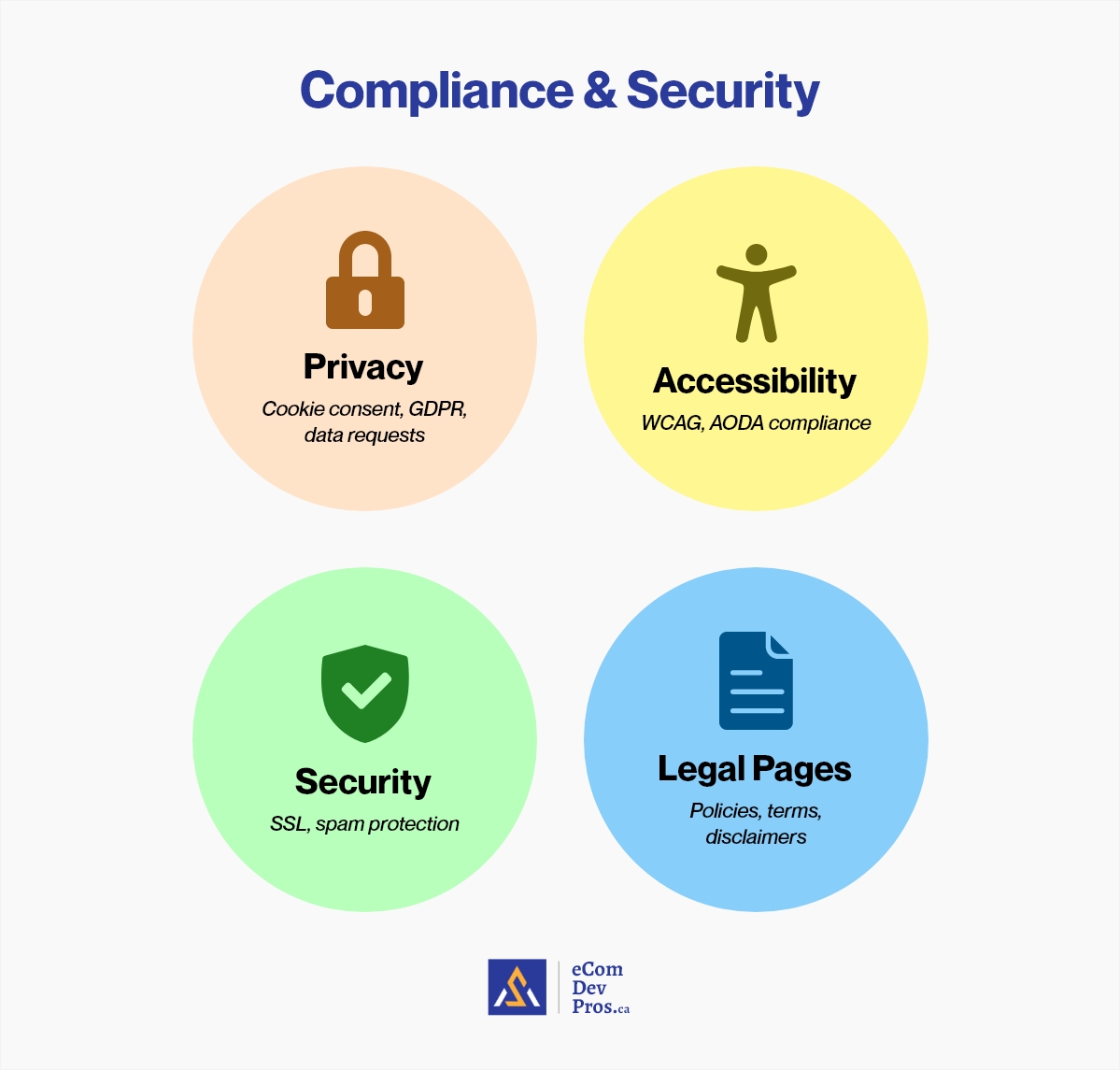
What Does Shopify Cover for Compliance and Security?
Shopify does a lot of the heavy lifting behind the scenes:
✅ Secure checkout (SSL)
✅ PCI compliance for all payment processing
✅ Built-in fraud protection tools
✅ Automatic platform and security updates
✅ 2FA (two-factor authentication) for admin accounts
You don’t need to manage your own server or buy an SSL certificate. That’s all included.
But some key parts of compliance are still your responsibility:
- Privacy laws — GDPR, CCPA, and other regional rules around customer data and consent
- Accessibility — Making sure your site works for screen readers, keyboard users, and meets WCAG or AODA standards
- Cookie banners & consent tools — Especially for stores targeting EU customers
- Legal pages — Terms, privacy policy, return policy, and disclaimers
- Customer data use — Like email opt-ins and how you handle unsubscribe requests
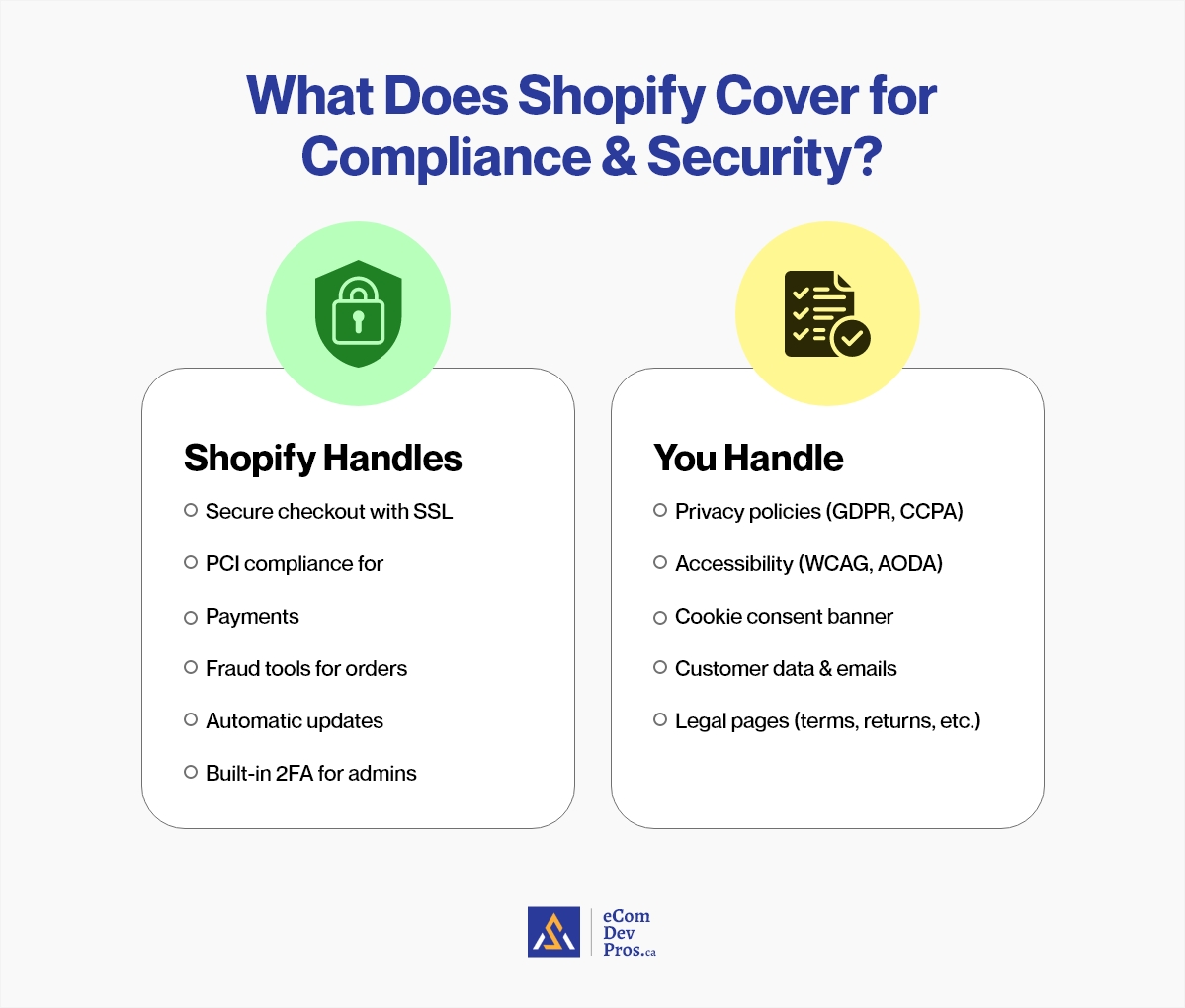
How much does Shopify Compliance and Security Cost?
Shopify Compliance and Security Costs |
|||
|---|---|---|---|
| Item | Cost | Recommended Tools | When It’s Needed |
| Cookie & privacy tools | $100–$500 per year | Cookiebot, Termly, Osano | At launch or when expanding to new regions |
| Accessibility testing/fixes | $1,000–$5,000+ | accessiBe, UserWay, EqualWeb | Before launch or major redesigns |
| Legal review | Varies | Templates via Shopify’s Policy Generator, or legal review through Termly | If you’re in regulated or high-risk spaces |
Why Accessibility and GDPR Aren’t Optional (Even for Small Stores)
If you’re selling in Canada, the U.S., the EU—or anywhere your store can be accessed—compliance laws apply to you.
It doesn’t matter if you’re a one-person brand.
It doesn’t matter if you’re “just starting out.”
- GDPR applies to any store collecting data from EU visitors
- CCPA applies to customer data and privacy in California
- AODA and WCAG impact any store that wants to serve customers with disabilities
These laws aren’t going away. And if your store isn’t accessible or privacy-compliant, you’re not just at legal risk—you’re turning customers away.
If you’re serious about building trust and avoiding headaches down the road, handle them early—and properly.
10. How Much Does Shopify Maintenance & Support Cost?
Your store doesn’t stop needing attention once it’s live.
- Apps need updating.
- Themes break and need updates.
- Shopify rolls out changes.
Something always comes up—and it usually happens right before a sales event or holiday season.
What Counts as Ongoing Shopify Maintenance?
Here’s what most stores need help with after launch:
- Content changes: Sales, seasonal updates, and new product launches
- CRO Enhancements: Continuous testing and UX updates to improve conversions over time, not just at launch.
- Regular Platform updates to keep your theme and apps compatible.
- Bug fixes: Things break. It happens. Whether it’s a broken layout or a checkout glitch, fast fixes matter.
- App maintenance: Apps update, too, as they don’t always play nicely with each other.
- Backup & recovery: When something is accidentally deleted, having a backup plan helps.
- Security monitoring: Apps, forms, and scripts still introduce risk. Regular checks help protect your data and that of your customers.
How much does Ongoing Shopify Maintenance and Support Cost?
You have the following maintenance and support models to choose from as per your requirements:
Shopify Maintenance and Support Cost |
||
|---|---|---|
| Type | Cost Range (CAD) | What You Get |
| DIY | $0 | Free if you know how—or have time to learn |
| One-off freelance help | $60–$250/hour | Fixes for bugs, broken layouts, or emergency issues |
| Monthly retainer | $300–$2,000/month | Ongoing support, site monitoring, and new updates each month |
| Theme/app support | Varies | Some offer free help, others charge per ticket |
| In-house support (larger brands) | Varies | Full-time or fractional teams for high-volume stores |
How to Budget for Ongoing Shopify Support Without Overpaying
Here’s the balance to strike:
Don’t overspend on support you don’t use.
But don’t wait until something breaks to find help either.
A few smart rules:
- Solo founder or new store? You probably don’t need a full plan. Just keep a freelancer on call.
- Growing traffic or running ads? A monthly plan can help you stay ahead of bugs and updates.
- Have an in-house dev or technical team? You might only need backup support for emergencies.
- Running promotions or high-volume sales? Make sure someone’s on standby, as Downtime = lost revenue.
11. How Much Does Shopify Marketing & Promotion Cost?
Marketing and promotion costs for Shopify stores typically range from $1,000 to $10,000+ per month, depending on your ad spend, content strategy, and channel mix.
Here’s what most Shopify brands spend on
1. Paid Advertising (Meta, Google, TikTok)
Best for: Fast traffic, testing products, and early momentum
Common uses: Retargeting, product ads, branded search
Recommended Tools:
- Meta Ads Manager – for Facebook/Instagram ads
- Google Ads – for branded search & shopping
- Triple Whale – for ad attribution and ROI tracking
Cost range:
- $600–$1,200/month to start
- $1,000–$10,000+/month to scale
- Creatives: $500–$5,000+ (optional)
Paid ads can deliver fast—but they burn cash if your offer or store isn’t ready.
2. Email & SMS Marketing
Best for: Recovering carts, re-engaging past visitors, driving repeat sales
Common uses: Welcome flows, promos, post-purchase emails
Recommended Tools:
- Klaviyo/Omnisend – email automation, segments, and flows
- Postscript – SMS campaigns, cart recovery
- Yotpo/Attentive – high-volume SMS with personalization
Cost range:
- $0–$500/month for tools like Klaviyo or Omnisend
- $500–$3,000 one-time if outsourcing copywriting/setup
Email and SMS are low-cost, high-impact, and should be in place from day one.
3. SEO & Content Marketing
Best for: Long-term traffic, organic discovery, brand trust
Common uses: Collection page SEO, product copy, blogs, FAQs
Recommended Tools:
- Ahrefs – keyword research, backlink analysis, competitor gaps
- Surfer SEO – on-page optimization + content scoring
- Google Search Console – monitor indexing, performance, site health
- Frase.io – content briefs, outline generation, NLP-driven suggestions
- Grammarly or Hemingway – improve clarity and readability
- Shopify Blog / Meta Fields – built-in blogging and structured content tools
Cost range:
- $500–$1,500 for initial setup
- $500–$5,000/month for ongoing content
SEO is slow but powerful. Start small now so it pays off later.
4. Social Media & UGC
Best for: Trust-building, organic reach, showing real people using your product
Common uses: Reposting customer content, reels/TikToks, social proof
Recommended Tools:
- Modash – find micro-influencers by audience + niche
- Billo – commission UGC-style video ads
- Influenster – discover creators + gather product reviews
Cost range:
- DIY: just your time
- Creators or tools: $100–$1,000/month
- Influencer campaigns: $500–$5,000+
You don’t need a huge following—just consistent, authentic content from real customers.
5. Analytics & Attribution
Best for: Tracking what’s working, optimizing spend
Common uses: LTV tracking, channel performance, revenue attribution
Recommended Tools:
- Google Analytics 4 (GA4) – tracks traffic, user journeys, conversion events
- Shopify Analytics – native dashboard for orders, top products, and channels
- Triple Whale – multi-channel attribution, ROAS tracking, LTV metrics
- Lifetimely – lifetime value, cohort analysis, product profitability
- Postscript/Klaviyo reporting – SMS/email campaign attribution
- Hotjar or Lucky Orange – behavior analytics to pair with attribution insights
Cost range:
- Free for Shopify Analytics + Google Analytics
- $30–$500/month for tools like Lifetimely or TripleWhale
- Up to $3k -$5k+/month with a data consultant (at scale)
When you’re spending money on ads, you need to know what’s bringing in revenue.
Where Should You Start Spending on Marketing and Promotion?
Here’s how to think about priorities based on your goals:
- Want Long-term organic growth – Start with SEO + blog content
- For Fast product validation – Go with Paid ads (Meta or Google)
- Getting traffic but need more conversions- AddEmail & SMS automation
- For building trust- Focus on reviews, UGC, and social proof
You don’t need to do everything. You just need the right first step for your store’s stage.
What is the Typical Monthly Marketing Budget for Shopify Websites (By Store Stage) |
|
|---|---|
| Store Stage | Monthly Budget Range (CAD) |
| Just launched | $300–$1,000 |
| Growing brand | $1,000–$5,000+ |
| Scaling store | $5,000–$40,000+ |
Is Shopify Worth the Investment?
Shopify isn’t always the cheapest way to launch an online store. But in most cases, it’s the smartest one if you build and scale it the right way.
What Makes Shopify Worth It
Shopify gives you more than a storefront. It includes:
- A platform that’s stable and doesn’t need constant fixes
- Hosting, SSL, and updates—already built into your plan
- Tools and apps that help you scale without hiring a full dev team
- A checkout flow that’s been tested (and proven) across millions of transactions
- In 2025, built-in AI tools will make setup, merchandising, and support faster than ever
When you compare that to custom builds or platforms that need heavy dev just to stay running, Shopify often comes out ahead in time, money, and flexibility.
What is the Total Cost of Ownership (TCO) of a Shopify Website?
Shopify is simple to start, but not always “cheap” to run.
The total cost of ownership (TCO) for a Shopify store in year one usually falls between $7,500 and $80,000+, including platform, design, development, content, and marketing.
Here’s what you’re investing in.
Shopify TCO (Total Cost of Ownership) Includes |
|
|---|---|
| Cost Area | Monthly/Annual Estimate (CAD) |
| Shopify Plan | $39–$399/month or USD 2300 (Shopify Plus) |
| Apps & Add-ons | $50–$500/month |
| Paid Themes | One-time $50–$500 |
| Development | $0–$30,000+ (project-based or ongoing) |
| Content Creation | $0–$3,000/month |
| SEO & CRO | $500–$5,000/month (outsourced) |
| Marketing & Ads | $300–$10,000+/month |
| Maintenance & Support | $100–$2,000/month |
| Domain & Email | $20–$50/year for domain; email extra |
| Compliance & Security | $100–$3,000+/year (audits, accessibility fixes) |
Lots of people focus on the setup cost. But the real cost is what you’ll spend to run and grow your store over time.
It adds up fast on other platforms in comparison to Shopify. With Shopify, most of it’s built in—or easy to plug in.
Shopify vs Other Platforms: TCO Comparison |
||||
|---|---|---|---|---|
| Platform | Build Cost | Monthly Cost | Maintenance Level | Year 1 TCO |
| Shopify | $5K–$50K+ | $200–$3,000+ | Low | $7.5K–$84K+ |
| WooCommerce | $3K–$40K+ | $30–$3,000+ | High | $8K–$100K+ |
| Magento | $10K–$100K+ | $500–$5,000+ | Very High | $20K–$200K+ |
| BigCommerce | $5K–$50K | $99–$2,000+ | Medium | $8K–$75K+ |
Behind the Numbers (TCO Notes)
- Build costs are based on real client ranges we’ve handled—everything from simple setup to custom development.
- Monthly costs include platform fees, apps, email tools, and optional support.
- TCO = Build Cost + (Monthly × 12) to reflect the true first-year cost of ownership.
- Enterprise-level costs (Shopify Plus) are excluded to keep this relevant for small to mid-sized brands.
- Data references: Shopify’s commissioned TCO study, platform documentation, and 17+ years of agency experience with eCommerce builds.
Final Take: What Does a Shopify Store Really Cost?
The real cost of a Shopify store isn’t just what you spend to launch — it’s what you invest to grow. Your year 1 TCO typically ranges from $7,500 to $80,000+, which covers the platform, design, apps, content, SEO, and marketing.
Compared to platforms like WooCommerce or Magento, Shopify keeps your maintenance low and your growth scalable — with most essentials built-in or easily extendable.
Shopify Website Design Cost: FAQ
How much does it cost to build a Shopify website?
Most stores spend $500 to $5,000+ to get started—depending on the theme, custom features, and how much help you hire.
👉 See our full Shopify Website Cost Breakdown
Can I build a Shopify website for free?
You can start a free trial and use free themes and tools—but you’ll still need to pay for a Shopify plan and your domain at a minimum.
So technically, no, not entirely free.
Why is Shopify so expensive?
Shopify is not expensive—if you use it right. Shopify handles hosting, security, checkout, updates, and more, which saves you a lot of money.
But costs add up when you add apps, paid themes, custom development, and marketing tools.
👉 See our Total Cost of Ownership guide for more.
How much does Shopify charge per sale?
Shopify takes no cut of your sales directly.
But you do pay transaction fees based on your plan:
- 2.4 %- 2.8% + 30¢ CAD online (3.3%-3.5% +30¢ CAD for Amex and international cards)
- 2.4 %- 2.6% + 0¢ CAD in person
- 0.6%–2% depending on your plan for third-party payment providers (third-party payment options other than Shopify Pay – PayPal, Stripe, BNPL payment options)
Do I need to hire a Shopify developer?
Not always, but it often pays off.
If you’re using a clean theme and a few solid apps, you can launch without custom code.
But if you need bundles, subscriptions, advanced filters, or B2B logic, a Shopify developer or agency brings speed, stability, and strategic thinking.
Instead of spending weeks learning the platform, you’re tapping into experience that avoids costly mistakes—and gets you live faster.
👉 Check our guide to Shopify Development Costs
How much should I budget for Shopify apps?
Most stores spend $50–$500/month on apps, depending on the stage.
Start with essentials only: email, reviews, SEO, and 1–2 key features, and more as you grow.
👉 See our Shopify App Cost Breakdown
What’s the best Shopify plan for new stores?
Start with Basic if you’re just testing your product.
Upgrade to Grow, advanced, or Plus Shopify plan when you need advanced reports or better shipping rates.
👉 Compare Shopify Plans Here
What’s the difference between using a paid theme and going custom?
A paid theme (typically $100–$500) is quick to launch and great for validating your idea. For better control, better user flows, and a unique customer experience, a custom Shopify design is recommended, and it ranges from $5000-$60,000.
What is the Total Cost of Ownership (TCO) for a Shopify store?
TCO of Shopify includes every cost over your first year: design, development, Shopify plan, apps, content, and ongoing marketing. The Shopify TCO for a mid-size store usually falls between $7,500 and $80,000+.
👉 Learn more about Shopify TCO here
Planning Your Shopify Store? Start Here.
Ready to Build Smart on Shopify?
You now know what goes into the real cost: platform fees, apps, design, development, and the stuff no one tells you upfront.
Whether you’re launching or scaling, we’ll help you map the right build—based on your goals, not guesswork.
Let’s talk about what your store needs—and what it should cost.
👉 Book your strategy call


